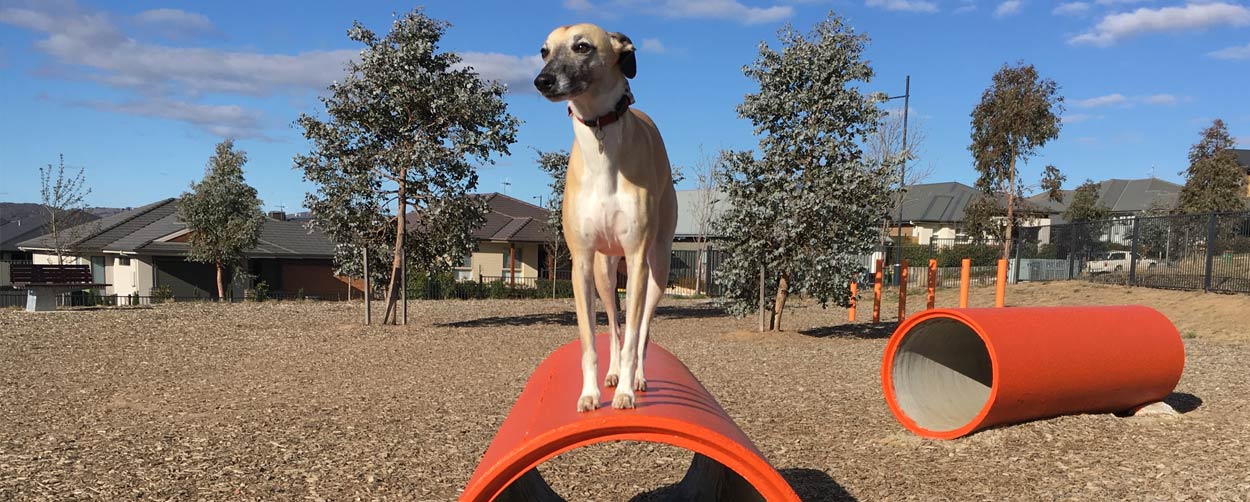Exercise
- Beat the heat by limiting your pets activity to early morning or late evening hours as this is when it is likely to be cooler
- Take breaks. If you are out walking, stop in the shade to rest a few times before continuing on.
- Sand and asphalt can get very hot and even burn your pets paws. Make sure that you test the surface by placing the back of your hand on the ground for 5 seconds, if you can't hold it there then the surface is too hot for your dog. You can also try protective dog booties however it may take some time for your pooch to get used to them
- Water. These days there are lots of dog pools around that can either be booked out for private sessions or for public use. This along with the backyard pool, a paddling pool or even an outdoor water activity is perfect for keeping your dog cool and providing them with hours of entertainment
 Image source: Lattitude Lakelands
Image source: Lattitude Lakelands
 Image source: @tah1ia
Image source: @tah1ia
Heatstroke
Dogs can be prime candidates for heatstroke on hot or humid days. Canine heatstroke is very similar to that of the human variety – the primary cause being the elevation of body temperature. Dogs generally self regulate their body temperature by panting. However when they are in a hot or humid climate or subject to too much exercise, they find it harder to breathe and to cool themselves down – in turn causing heat stroke. Dog breeds with shorter noses such as; pugs, bulldogs and staffies are much more susceptible to breathing difficulties and should try to avoid any heat exposure.What to look out for?
- Persistent panting and agitation
- Bright coloured red gums
- Nausea, vomiting or diarrhoea
- Elevated heart rate (above 120 beats per 60sec)
- Elevated temperature (above 39.5C)
- Weakness
- Muscle tremors
How to treat heatstroke?
However, if this isn’t possible you could try keeping them comfortable and cooling them down by;
- Moving them to a cool shaded area or an air conditioned space
- Offering them water
- Placing a fan in-front of them
- Wetting down your dog and the surrounding area
Tips for keeping cool
- Frozen treats: Try freezing treats in your dog’s kong, this will keep them amused and cool them down!
- Haircuts: In some instances giving your dog a haircut in the summer months works wonders for keeping them cool. However, you should remember that they still need a minimum of at least 1 inch of hair to protect them from the sun, so no shaving them.
- Provide plenty of shade and fresh water, your dog should always have access to drinking water
Slithering snakes
Snakebite symptoms can include;
- Sudden weakness
- Collapsing
- Shaking
- Muscle twitching
- Unresponsive to light, dilated pupils
(Source: Dr Belinda Beynon, Serpentine Vet)

Doggie destinations
Here at Peet we have a number of communities with dedicated dog parks, that have been specially designed and constructed with dogs in mind.Googong, NSW

Riverbank, QLD

Flagstone, QLD (water based)
Meet some of our Peet dogs

It's a Paw Party 🎉🐾 #PawParty #Flagstone #flagstonelife #weekends #adventure #cutie #thoseeyes #puppy #cavoodle #cavoodlesofinsta #dogsofinstagram #dogmodel #follow #PrincessMia

Enjoying the sunset🌄 #lightsviewlife #creamyncoffee

yay!!! My favourite time of the day!! 😀😀#goldenbaylife #williamthelabrador #callmebilly

Oh my goodness, I pulled off my first eva dog park. I even went freestylin off leash. Dis guy is @frank_the_tank_deafdane #frank_the_tank_deafdane @mimslife12
He is my bodyguard
#rescuedogsrule
@abcrinc
#flagstonelife
#australiancattledogs

Still love this photo! #goldenbaylife

You know when you go to a party and there's usually one weirdo in the room? Well.. today that weirdo was me 😝.
.
The Flagstone Dog Park launch pawty had these massive balloons decorating the whole park and it was my one and only mission today to pop it 🙈.

My neighbours! #springerspaniel #yanchep #yanchepgoldestate #dog #dogs #kangaroos #neighbours #doggy

#dobermanlove #movidalife

Had a whale of a time at the paw party held by Flagstone Estate for the opening of their new dog water park!🐳💦🐾


